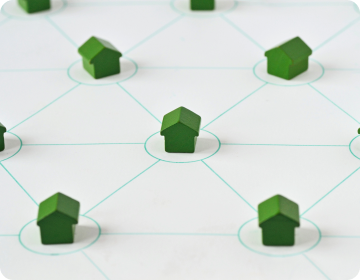A market-wide infrastructure and intelligent backbone that connects systems and orchestrates the exchange of data throughout the property market. It harmonises the digital transaction, like a conductor getting the best performance from their orchestra, ensuring that every component of the transaction works in sync.
Let’s dive into exactly how orchestration connects the digitised patchwork of process together, the critical requirements to make it a reality, and Coadjute’s chapter in this story.
One platform for the whole property market
For a long time, the commonly held assumption has been that the only way to create a digital property market and get a single unified view of the property transaction was for everyone to use the same central platform, for example, a central government-mandated e-conveyancing platform.
This idea has been around for over 20 years now (see the 2002 Property Act), where all aspects of a transaction, from the provision of information to the registration of sales, would occur electronically in a central system. While there have been many attempts to build this, we find ourselves in 2024 and with no such centralised platform. The reality is that estate agents, brokers, conveyancers, lenders, and other property market businesses are very different and each requires software tailored to their specific needs, rather than adopting a single monolithic system
Orchestration: building true connections
Recognising that a centralised platform is not a realistic answer, we have seen an increase in advocation for a more collaborative model, where the constituent elements of the property transaction are connected and interoperable. This has recently gained more significant traction because the technology is now available to make it possible, with open APIs and Distributed Ledger Technology.
For a truly digital property market to flourish it doesn’t just need connection, it needs orchestration.
With its efficient coordination of the various tasks, activities and events in a property transaction, orchestration brings together the different business processes of parties involved into a seamless digital journey.
The integration and connections built between different systems and data by orchestration ensures smooth and synchronised operations throughout the property transaction. It quietly coordinates activities like document sharing, legal processes, enquiries, property data, transaction data, digital identity data and payments data between everyone involved.
This is the foundation of a truly digital property market.
Arranging a harmonious property transaction
Effective orchestration promises a transaction experience that is smooth, uninterrupted, and certain. What orchestration achieves when implemented correctly cannot be exaggerated enough:
Bridging the fragmentation
Orchestration creates a common ecosystem, bridging the gaps between processes and parties that are siloed and fragmented. In an orchestrated system, no one needs to prove their identity more than once, as it knows they are the same person. Data is never duplicated, or inconsistent, as the orchestration layer ensures everyone is looking at the same common view of the truth. Finally, an orchestrated system understands the order in which things have happened. Unlike a cat’s cradle of APIs, in an orchestrated system there is order between all the parties.
Unifying the consumer journey
Creating a common ecosystem for the entire property market, and not just parts of it, is music to the ears of those buyers and sellers who have, for far too long, suffered the stresses and frictions of the process. Consumers would benefit from a truly unified digital journey and experience, the likes of which the market has been so slowly striving to achieve. A seamless digital experience from start to finish, the integration of various systems, platforms, and technologies will create a truly coherent transaction flow. Finally, everyone is on the same page; with the shared knowledge of what has gone before and what’s coming up next. A customer experience we would all be grateful for.
A more promising future for the Digital Property Market
The UK property market started its digitisation journey over two decades ago, and within each market segment, leading software providers have enabled firms to digitise and optimise their operations. The progress must be commended, however, despite our best efforts the process is opaque and fragmented for all its participants. It’s high time for new ideas.
Orchestration, along with the components described earlier, give the property industry what it has lacked to date: an ability for every part, and every party, to function in the same environment, in a common ecosystem. It is, along with the other components, the solution to the problem of the broken property industry and the only way to avoid repeating and re-encountering the same problems we have today.
The digital property market represents a significant shift in how we engage with property transactions. It's about building an ecosystem that’s not only more efficient and secure but also more equitable and accessible. With the right foundation, we can look forward to a future where buying, selling, and the property market itself are fundamentally transformed for the better.
That’s why at Coadjute, we have developed and launched exactly such an orchestration network and are now enabling for the first time the market to unite and operate in this new and truly digital way.
This article was originally published on the Coadjute blog on 12 December 2023.
Check out the Coadjute website for more blogs on the digital property market.






.png)






.png)


.jpg)




.png)



Join the conversation
Be the first to comment (please use the comment box below)
Please login to comment